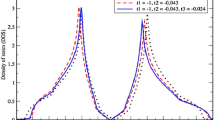Abstract
For single-layer graphene placed on a metal substrate, the influence of intra- and interatomic Coulomb repulsion of electrons (U and G, respectively) on its phase diagram is considered in the framework of an extended Hartree-Fock theory. The general solution of the problem is presented, on the basis of which special cases allowing for analytical consideration are analyzed: free and epitaxial graphene with and without regard for the energy of the electron transition between neighboring atoms of graphene. Three regions of the phase diagram are considered: spin and charge density waves (SDW and CDW, respectively) and the semimetal (SM) state uniform in the spin and charge. The main attention is paid to undoped graphene. It is shown that the allowance for the interaction with a metal substrate expands the SM existence domain. However, in all the considered cases, the boundary between the SDW and CDW states is described by the equation U = zG, where z = 3 is the number of nearest neighbors in graphene. The widening of the SM state region also results from the doping of graphene, and the effect is independent of the sign of free carriers introduced into epitaxial graphene by the substrate. According to estimates made, the only state possible in the buffer layer is the metal-type SM state, whereas, in epitaxial graphene, the CDW state is possible. The influence of temperature on the phase diagram of epitaxial graphene is discussed.
Similar content being viewed by others
References
A. H. Castro Neto, F. Guinea, N. M. R. Peres, K. S. Novoselov, and A. K. Geim, Rev. Mod. Phys. 81, 109 (2009).
V. N. Kotov, B. Uchoa, V. M. Pereira, A. H. Castro Neto, and F. Guinea, Rev. Mod. Phys. 84, 1067 (2012).
N. Swain and P. Majumdar, arXive: 1610.00695.
M. V. Ulybyshev, P. V. Buividovich, M. I. Katsnelson, and M. I. Polikarpov, Phys. Rev. Lett. 111, 056801 (2013).
L. Wang, P. Corboz, and M. Troyer, New J. Phys. 16, 103008 (2014).
M. Hohenadler, F. P. Toldin, I. F. Herbut, and F. F. Assaad, Phys. Rev. B 90, 085146 (2014).
W. Wu and A.-M. S. Tremblay, Phys. Rev. B 89, 205128 (2014).
L. Classen, I. F. Herbut, L. Janssen, and M. M. Scherer, Phys. Rev. B 92, 035429 (2015).
S. Yu. Davydov, Sov. Phys. Solid State 20, 1013 (1978).
S. Yu. Davydov, Semiconductors 48, 46 (2014).
S. Yu. Davydov, Adsorption Theory: Method of Model Hamiltonians (SPbGETU LETI, and St. Petersburg, 2013) [in Russian].
S. Yu. Davydov, Sov. Phys. Solid State 21, 1314 (1979).
D. I. Khomskii, Fiz. Met. Metalloved. 29, 31 (1970).
E. V. Kuz’min, G. A. Petrakovskii, and E. A. Zavadskii, Physics of Magnetically Ordered Materials (Nauka, Novosibirsk, 1976) [in Russian].
T. Moriya, Spin Fluctuations in Itinerant Electron Magnetism (Springer, Berlin, 1985).
S. Yu. Davydov, Semiconductors 46, 193 (2012).
S. Yu. Davydov, Phys. Solid State 58, 804 (2016).
J. E. Hirsh, Phys. Rev. Lett. B 53, 2327 (1984).
V. Zhang and J. Callaway, Phys. Rev. B 39, 9397 (1989).
J. van den Brink, M. B. J. Meinders, J. Lorenzana, R. Eder, and G. A. Sawatzky, Phys. Rev. Lett. 75, 4658 (1995).
P. Sengupta, A. W. Sandvik, and D. K. Campbell, Phys. Rev. B 65, 155113 (2002).
T. O. Wehling, E. Şaşιoğlu, C. Friedrich, A. I. Lichtenstein, and M. I. Katsnelson, and S. Blügel, Phys. Rev. Lett. 106, 236805 (2011).
Ch. Kittel, Quantum Theory of Solids (Wiley, New York, 1963, Nauka, Moscow, 1967).
S. Yu. Davydov, Semiconductors 47, 95 (2013).
Z. Y. Meng, T. C. Lang, S. Wessel, F. F. Assaad, and A. Muramatsu, Nature 464, 847 (2010).
S. Sorella, Y. Otsuka, and S. Yunoki, Sci. Rep. 2, 992 (2012).
A. G. Grushin, E. V. Castro, A. Cortijo, F. de Juan, M. A. H. Vozmediano, and B. Valenzuela, Phys. Rev. B 87, 085136 (2013).
X. Y. Xu, S. Wesse, and Z. Y. Meng, Phys. Rev. B 94, 116105 (2016).
W. A. Harrison, The Electronic Structure and Properties of Solids (Freeman, San Francisco, CA, 1980), Vol. 2.
Physical Values, The Handbook, Ed. by I. S. Grigor’ev and E. Z. Meilikhov (Energoatomizdat, Moscow, 1991) [in Russian].
V. Yu. Irkhin and Yu. P. Irkhin, The Electronic Structure, Correlation Effects and Physical Properties of D- and F-Metals and Their Compounds (Regulyar. Khaotich. Dinamika, Moscow, Izhevsk, 2008, Cambridge Int., Cambridge, MA, 2007).
R. Hovdena, A. W. Tsen, P. Liua, B. H. Savitzky, I. El Baggari, Y. Liu, W. Lu, Y. Sun, P. Kim, A. N. Pasupathy, and L. F. Kourkoutis, Proc. Nat. Acad. Sci. USA 113, 11420 (2016).
J. W. F. Venderbos, M. Manzardo, D. V. Efremov, J. van den Brink, and C. Ortix, Phys. Rev. B 93, 045428 (2016).
S. Yu. Davydov, Tech. Phys. 61, 1106 (2016).
Author information
Authors and Affiliations
Corresponding author
Additional information
Original Russian Text © S.Yu. Davydov, 2017, published in Fizika Tverdogo Tela, 2017, Vol. 59, No. 8, pp. 1650–1658.
Rights and permissions
About this article
Cite this article
Davydov, S.Y. The role of electron–electron repulsion in the problem of epitaxial graphene on a metal: Simple estimates. Phys. Solid State 59, 1674–1682 (2017). https://doi.org/10.1134/S1063783417080078
Received:
Accepted:
Published:
Issue Date:
DOI: https://doi.org/10.1134/S1063783417080078



